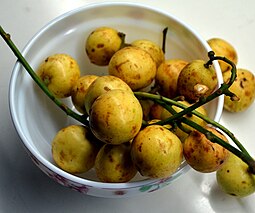Baccaurea ramiflora
This article needs additional citations for verification. (April 2019) |
| Baccaurea ramiflora | |
|---|---|

| |
| Baccaurea ramiflora | |
| Scientific classification | |
| Kingdom: | Plantae |
| Clade: | Tracheophytes |
| Clade: | Angiosperms |
| Clade: | Eudicots |
| Clade: | Rosids |
| Order: | Malpighiales |
| Family: | Phyllanthaceae |
| Genus: | Baccaurea |
| Species: | B. ramiflora
|
| Binomial name | |
| Baccaurea ramiflora Lour., 1790
| |
Baccaurea ramiflora,[1] the Burmese grape,[2] is a slow-growing evergreen tree in the family Phyllanthaceae, growing to 25 m, with a spreading crown and thin bark. It is found throughout Asia, most commonly cultivated in Burma, Cambodia, Laos, Vietnam, India, Bangladesh and Malaysia.[3] It grows in evergreen forests on a wide range of soils. The fruit is harvested and used locally, eaten as a fruit, stewed or made into wine; it is also used medicinally to treat skin diseases. The bark, roots and wood are harvested for medicinal uses.
The fruit is oval, colored yellowish, pinkish to bright red or purple, 2.5–3.5 cm in diameter, glabrous, with 2–4 large purple-red seed, with white aril.

Bark, roots, and wood are dried and ground before boiling in water. Fruits can be kept fresh for 4–5 days, or boiled and mixed with salt after which it keeps well in closed jars. Marginal importance of the fruit, locally used and sold.
The name of this fruit differs throughout Asia – the common names used with this fruit in Bangladesh is bubbi in Sylhet and in Dhaka it is known as "'lotkon'".
References
- ^ Lour. (1790) In: Fl. Cochinch.: 661
- ^ "Baccaurea ramiflora". Germplasm Resources Information Network. Agricultural Research Service, United States Department of Agriculture. Retrieved 4 June 2018.
- ^ "Baccaurea ramiflora - Useful Tropical Plants". tropical.theferns.info. Retrieved 2019-09-17.
